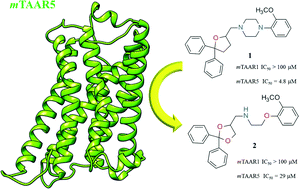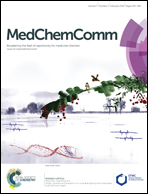A homology modelling-driven study leading to the discovery of the first mouse trace amine-associated receptor 5 (TAAR5) antagonists†‡
Abstract
Several recent studies have focused on a detailed analysis of the trace amine-associated receptor type 5 (TAAR5) pharmacology, up to now revealing only a limited number of species-specific ligands, which are also active towards other TAAR receptors. In this context, we developed our work on TAAR5 applying a structure-based computational protocol, revolving around homology modeling and virtual screening calculations. In detail, mTAAR5 and hTAAR5 homology models were built, in order to explore any pattern of structural requirements which could be involved in species-specific differences. Successively, the mTAAR5 model was employed to perform a virtual screening of an in-house library of compounds, including different five-membered ring derivatives, linked to a phenyl ring through a flexible or a rigid basic moiety. The computational protocol applied allowed to select a number of chemical scaffolds that were tested in a biological assay leading to the discovery of the first two mTAAR5 antagonists.


 Please wait while we load your content...
Please wait while we load your content...